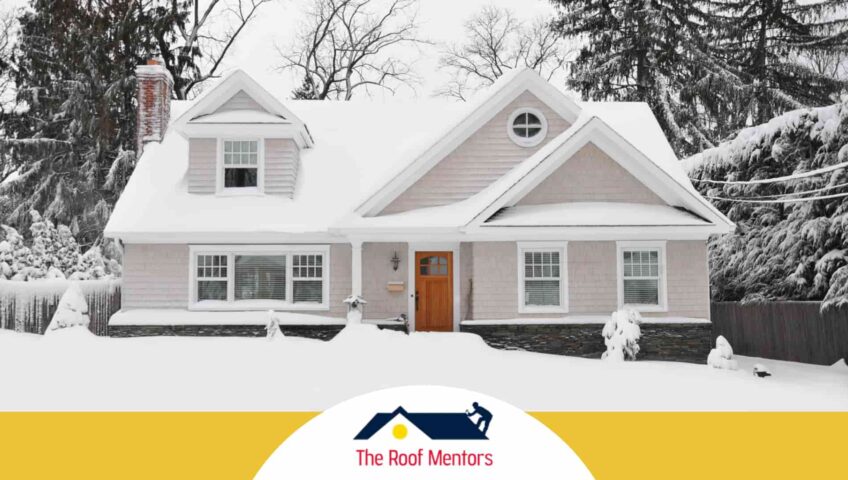Since winter is known to be particularly harsh on roofing systems, causing various issues, it’s important to try and stay one step ahead of them.
The best way to do that is by educating yourself on what you, as a homeowner, can expect in the following unpredictable months. That way, you’ll be able to tackle the issues early on and keep your home safe and sound.
It’s rarely a good idea to just leave your roof at the mercy of the outside elements, hoping for the best and waiting until spring to address any potential issues. On the other hand, it’s always a good idea to deal with problems as they come or try to prevent them altogether with the help of an experienced professional.
With that in mind, let’s have a look at the biggest roofing issues you should watch out for this winter so that you can prepare yourself (and your roof) adequately.
Snow Damage
Snow can do much more damage to a roof than most people think.
When snow falls on your roof, the heat emitted by your home slowly melts it and drains it through the gutters. But, when there’s more snow on your roof than can drain on its own, it will start to accumulate and begin to seep under the shingles. So, be very careful when it comes to this, as it could lead to major roofing issues.
One thing you can do is use a shovel and try to remove the snow yourself, but be cautious not to hurt yourself or accidentally damage your roof. Furthermore, some homeowners also use salt or calcium chloride when attempting to melt the snow, which is another good idea, but we urge you to be as careful as possible. If not used properly, there’s a small risk that it might cause some unfortunate damage to your roof.
If you don’t feel comfortable doing these things yourself, that’s okay! You can always leave it to roof professionals, such as The Roof Mentors, to keep your roof in top shape during these months. After all, it’s your best chance at staying safe from the cold, avoiding damaging your roof, and keeping your warranty.
Ice Dams
When it comes to winter roof dangers, ice dams are among the most common issues that can occur on your roofing system. They are especially likely to form on roofs in areas with an abundance of snow and ice.
So, what exactly causes ice dam formation, and what can you do about it?
The main reason you often notice ice dams on your roof is the uneven temperature distribution. Typically, the upper areas of your roof are warmer because of the warm air that rises from the inside of your home. But the lower-hanging areas, such as roof edges, tend to be much cooler.
The snow accumulating on the roof will start melting towards the cold edges and then freeze, creating a layer of ice that we call ice dams. The larger and thicker they grow, the more dangerous they are, as they can cause water to seep under the shingles and straight into your home.
To get rid of this problem, you should have your gutters cleaned before winter, making it easier for the melted snow to run off of the roof. Also, consider installing proper attic insulation and ventilation to prevent your roof from overheating.
And finally, to minimize the risk of melted snow refreezing, you can try raking it off of the roof as soon as it starts accumulating, especially from the edges.
Icicles
Icicles are similar to ice dams, and they are the result of the exact same processes mentioned above.
In addition to ice dams, clogged gutters and downspouts will further enable the formation of icicles. They will allow the water from the melted snow to pool inside the gutters and the edges of the roof, inevitably leading to icicle formation when the temperatures drop below freezing.
While icicles may sometimes look appealing, they are a serious hazard for you and your roofing system. They can easily fall down, which can be a huge safety risk if you or your loved ones are walking beneath them.
Moreover, their weight can prove to be too much for your gutters, fascia, and roof edges to handle, pulling them down and even damaging them.
Fortunately, the same principles that will help you get rid of ice dams work here as well. Keep your gutters clean and unobstructed, make sure your ventilation is fully functioning and clear the snow frequently.
Attic Condensation
Did you know that winter and snow can cause just as much damage to the interior of your home as to the exterior? Not to mention that these types of problems often lead to even more serious issues.
When heating your home during the winter months, the hot air will rise all the way to the attic, and without a proper way to escape, it will keep lingering there. Upon coming in contact with a cool surface on the roof, the hot air will condensate, creating moisture build-up in the attic.
The moisture will continue to cause mold and mildew formation and wood rot, all of which can be a health and safety hazard for your family, as well as your property. So, what’s the best way to stay ahead of attic condensation?
It’s actually quite simple. All you have to do is make sure that you have proper attic ventilation and insulation. They will control indoor temperatures and allow the air to circulate in the enclosed space.
Stay Safe This Winter
While winter is undeniably a beautiful season that brings many joys, it also comes with some risks to your home. Luckily, with proper preparation and the necessary safety measures in place, you can easily steer clear of all of these damages and have a problem-free winter.
Your #1 roofers Fayetteville NC are here to help you keep winter damages at bay, so don’t hesitate to reach out to us in case you’re experiencing any of the mentioned issues or if you simply want a roof check-up.


